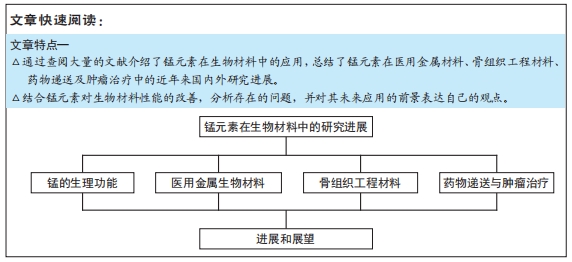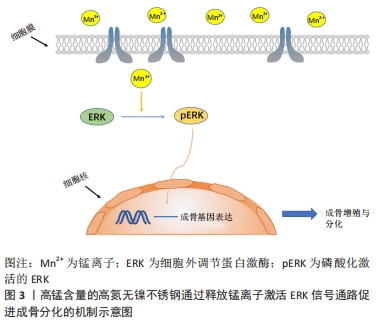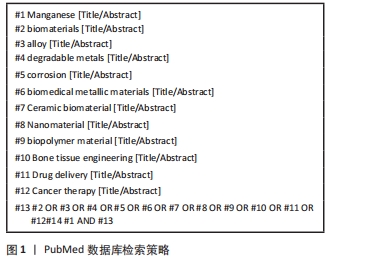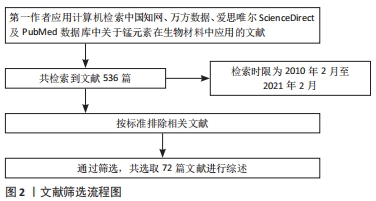[1] 江权.锰的存在及应用[J].中国锰业,2001,19(3):37-39.
[2] 卫潇茗,王晨光,张睿,等.锰离子作为免疫调节剂的发现及应用展望[J].中国细胞生物学学报,2020,42(10):1721-1731.
[3] HORNING KJ, CAITO SW, TIPPS KG, et al. Manganese is essential for neuronal health. Annu Rev Nutr. 2015;35:71-108.
[4] HREHA J, WEY A, CUNNINGHAM C, et al. Local manganese chloride treatmentaccelerates fracture healing in a rat model. J Orthop Res. 2015;33(1):122-130.
[5] LI L, YANG X. The essential element manganese, oxidative stress, and metabolic diseases: links and interactions. Oxid Med Cell Longev. 2018; 2018:7580707.
[6] 郭书含,宋平平,陈曾曾,等.人骨髓间充质干细胞脑内移植治疗锰中毒模型的可行性[J].中国组织工程研究,2018,22(9):1402-1406.
[7] LÜTHEN F, BULNHEIM U, MÜLLER PD, et al. Influence of manganese ions on cellular behavior of human osteoblasts in vitro. Biomol Eng. 2007;24(5):531-536.
[8] PARK JW, KIM YJ, JANG JH. Surface characteristics and in vitro biocompatibility of a manganese-containing titanium oxide surface. Applied Surface Science. 2011;258(2):977-985.
[9] HALL ER, SLACK RJ. The effect of divalent metal cations on the αv integrin binding site is ligand and integrin specific. Biomed Pharmacother. 2019; 110:362-370.
[10] VORUP-JENSEN T, WALDRON TT, ASTROF N, et al. The connection between metal ion affinity and ligand affinity in integrin I domains. Biochimica et Biophysica Acta. 2007;1774(9):1148-1155.
[11] SHARMA N, JANDAIK S, KUMAR S, et al. Synthesis, characterisation and antimicrobial activity of manganese- and iron-doped zinc oxide nanoparticles. J Exp Nanosci. 2015;11(1):54-71.
[12] GU Y, ZHANG J, ZHANG X, et al. Three-dimensional printed mg-doped β-tcp bone tissue engineering scaffolds: effects of magnesium ion concentration on osteogenesis and angiogenesis in vitro. Tissue Eng Regen Med. 2019;16(4):415-429.
[13] YANG K, ZHOU C, FAN H, et al. Bio-functional design, application and trends in metallic biomaterials. Int J Mol Sci. 2017;19(1):24.
[14] ZARTNER P, CESNJEVAR R, SINGER H, et al. First successful implantation of a biodegradable metal stent into the left pulmonary artery of a preterm baby. Catheter Cardiovasc Interv. 2005;66(4):590-594.
[15] LI Y, WANG L, CHEN S, et al. Biodegradable magnesium alloy stents as a treatment for vein graft restenosis. Yonsei Med J. 2019;60(5):429-439.
[16] OTTRIA L, LAURITANO D, ANDREASI BASSI M, et al. Mechanical, chemical and biological aspects of titanium and titanium alloys in implant dentistry. J Biol Regul Homeost Agents. 2018;32(2 Suppl 1): 81-90.
[17] LI Y, DING Y, MUNIR K, et al. Novel β-Ti35Zr28Nb alloy scaffolds manufactured using selective laser melting for bone implant applications. Acta Biomater. 2019;87:273-284.
[18] APOSTU D, LUCACIU O, BERCE C, et al. Current methods of preventing aseptic loosening and improving osseointegration of titanium implants in cementless total hip arthroplasty: a review. J Int Med Res. 2018;46(6):2104-2119.
[19] SU Y, COCKERILL I, WANG Y, et al. Zinc-based biomaterials for regeneration and therapy. Trends Biotechnol. 2019;37(4):428-441.
[20] MOSTAED E, SIKORA-JASINSKA M, DRELICH JW, et al. Zinc-based alloys for degradable vascular stent applications. Acta Biomater. 2018;71: 1-23.
[21] FRANCIS A, YANG Y, VIRTANEN S, et al. Iron and iron-based alloys for temporary cardiovascular applications. J Mater Sci Mater Med. 2015; 26(3):138.
[22] QI Y, QI H, HE Y, et al. Strategy of metal-polymer composite stent to accelerate biodegradation of iron-based biomaterials. ACS Appl Mater Interfaces. 2018;10(1):182-192.
[23] DÍAZ M, SEVILLA P, GALÁN AM, et al. Evaluation of ion release, cytotoxicity, and platelet adhesion of electrochemical anodized 316 L stainless steel cardiovascular stents. J Biomed Mater Res B Appl Biomater. 2008;87(2):555-561.
[24] HU H, CUI R, MEI L, et al. Cytocompatibility and bone-formation potential of se-coated 316L stainless steel with nano-pit arrays. J Biomed Nanotechnol. 2018;14(4):716-724.
[25] MADL AK, LIONG M, KOVOCHICH M, et al. Toxicology of wear particles of cobalt-chromium alloy metal-on-metal hip implants Part I: physicochemical properties in patient and simulator studies. Nanomedicine. 2015;11(5):1201-1215.
[26] Wang H, Lim JY. Metal-ceramic bond strength of a cobalt chromium alloy for dental prosthetic restorations with a porous structure using metal 3D printing. Comput Biol Med. 2019;112:103364.
[27] RAZAVI M, HUANG Y. Assessment of magnesium-based biomaterials: from bench to clinic. Biomater Sci. 2019;7(6):2241-2263.
[28] BEKMURZAYEVA A, DUNCANSON WJ, AZEVEDO HS, et al. Surface modification of stainless steel for biomedical applications: revisiting a century-old material. Mater Sci Eng C Mater Biol Appl. 2018;93:1073-1089.
[29] KIRADZHIYSKA DD, MANTCHEVA RD. Overview of biocompatible materials and their use in medicine. Folia Med (Plovdiv). 2019;61(1): 34-40.
[30] STAIGER MP, PIETAK AM, HUADMAI J, et al. Magnesium and its alloys as orthopedic biomaterials: a review. Biomaterials. 2006;27(9): 1728-1734.
[31] YANG Y, WU P, WANG Q, et al. The Enhancement of Mg Corrosion Resistance by Alloying Mn and Laser-Melting. Materials (Basel). 2016; 9(4):216.
[32] YU Z, TANG A, WANG Q, et al. High strength and superior ductility of an ultra-fine grained magnesium–manganese alloy. Mater Sci Eng A. 2015;648:202-207.
[33] YU Z, TANG A, HE J, et al. Effect of high content of manganese on microstructure, texture and mechanical properties of magnesium alloy. Materials Characterization. 2018;136:310-317.
[34] JIA B, YANG H, HAN Y, et al. In vitro and in vivo studies of Zn-Mn biodegradable metals designed for orthopedic applications. Acta Biomater. 2020;108:358-372.
[35] SUN J, ZHANG X, SHI ZZ, et al. Development of a high-strength Zn-Mn-Mg alloy for ligament reconstruction fixation. Acta Biomater. 2021;119: 485-498.
[36] DARGUSCH MS, DEHGHAN-MANSHADI A, SHAHBAZI M, et al. Exploring the role of manganese on the microstructure, mechanical properties, biodegradability, and biocompatibility of porous iron-based scaffolds. ACS Biomater Sci Eng. 2019;5(4): 1686-1702.
[37] CARLUCCIO D, XU C, VENEZUELA J, et al. Additively manufactured iron-manganese for biodegradable porous load-bearing bone scaffold applications. Acta Biomater. 2020;103:346-360.
[38] COSTA BC, TOKUHARA CK, ROCHA LA, et al. Vanadium ionic species from degradation of Ti-6Al-4V metallic implants: in vitro cytotoxicity and speciation evaluation. Mater Sci Eng C Mater Biol Appl. 2019;96: 730-739.
[39] HARUN WSW, KAMARIAH MSIN, MUHAMAD N, et al. A review of powder additive manufacturing processes for metallic biomaterials. Powder Technol. 2018;327:128-151.
[40] ALSHAMMARI Y, YANG F, BOLZONI L. Mechanical properties and microstructure of Ti-Mn alloys produced via powder metallurgy for biomedical applications. J Mech Behav Biomed Mater. 2019;91:391-397.
[41] KIM JW, HWANG MJ, HAN MK, et al. Effect of manganese on the microstructure, mechanical properties and corrosion behavior of titanium alloys. Mater Chem Phys. 2016;180:341-348.
[42] ZHANG F, BURKEL E. Novel titanium manganese alloys and their macroporous foams for biomedical applications prepared by field assisted sintering. Biomed Eng. 2011:203-224.
[43] SANTOS PF, NIINOMI M, CHO K, et al. Microstructures, mechanical properties and cytotoxicity of low cost beta Ti-Mn alloys for biomedical applications. Acta Biomater. 2015;26:366-376.
[44] SANTOS PF, NIINOMI M, LIU H, et al. Fabrication of low-cost beta-type Ti-Mn alloys for biomedical applications by metal injection molding process and their mechanical properties. J Mech Behav Biomed Mater. 2016;59:497-507.
[45] MATUSIEWICZ H. Potential release of in vivo trace metals from metallic medical implants in the human body: from ions to nanoparticles--a systematic analytical review. Acta Biomater. 2014;10(6):2379-2403.
[46] YU Y, DING T, XUE Y, et al. Osteoinduction and long-term osseointegration promoted by combined effects of nitrogen and manganese elements in high nitrogen nickel-free stainless steel. J Mater Chem B. 2016;4(4):801-812.
[47] ASRI RIM, HARUN WSW, SAMYKANO M, et al. Corrosion and surface modification on biocompatible metals: a review. Mater Sci Eng C Mater Biol Appl. 2017;77:1261-1274.
[48] YU L, TIAN Y, QIAO Y, et al. Mn-containing titanium surface with favorable osteogenic and antimicrobial functions synthesized by PIII&D. Colloids Surf B Biointerfaces. 2017;152:376-384.
[49] ANANTH KP, SUN J, BAI J. An innovative approach to manganese-substituted hydroxyapatite coating on Zinc oxide-coated 316L SS for implant application. Int J Mol Sci. 2018;19(8):2340.
[50] 廖欣宇,王福科,王国梁.骨组织工程支架的进展与挑战[J].中国组织工程研究,2021,25(28):4553-4560.
[51] NAWAZ Q, UR REHMAN MA, ROETHER JA, et al. Bioactive glass based scaffolds incorporating gelatin/manganese doped mesoporous bioactive glass nanoparticle coating. Ceram Int. 2019;45(12):14608-14613.
[52] RAU JV, FADEEVA IV, FOMIN AS, et al. Sic Parvis magna: manganese-substituted tricalcium phosphate and its biophysical properties. ACS Biomater Sci Eng. 2019;5(12):6632-6644.
[53] MUTHUSAMY S, MAHENDIRAN B, SAMPATH S, et al. Hydroxyapatite nanophases augmented with selenium and manganese ions for bone regeneration: physiochemical, microstructural and biological characterization. Mater Sci Eng C Mater Biol Appl. 2021;126:112149.
[54] LALA S, GHOSH M, DAS PK, et al. Mechanical preparation of nanocrystalline biocompatible single-phase Mn-doped A-type carbonated hydroxyapatite (A-cHAp): effect of Mn doping on microstructure. Dalton Trans. 2015;44(46):20087-20097.
[55] PARK SY, CHOE DH. Bone-like apatite formation on the plasma electrolytic oxidation-treated Ti-6Al-4V alloy in solution containing Si and Mg Ions. J Nanosci Nanotechnol. 2018;18(2):1439-1441.
[56] BARRIONI BR, NORRIS E, LI S, et al. Osteogenic potential of sol-gel bioactive glasses containing manganese. J Mater Sci Mater Med. 2019; 30(7):86.
[57] BARRIONI BR, OLIVEIRA AC, DE FÁTIMA LEITE M, et al. Sol–gel-derived manganese-releasing bioactive glass as a therapeutic approach for bone tissue engineering. J Mater Sci. 2017;52(15):8904-8927.
[58] WU T, SHI H, LIANG Y, et al. Improving osteogenesis of calcium phosphate bone cement by incorporating with manganese doped β-tricalcium phosphate. Mater Sci Eng C Mater Biol Appl. 2020;109: 110481.
[59] YU L, ROWE DW, PERERA IP, et al. Intrafibrillar mineralized collagen-hydroxyapatite-based scaffolds for bone regeneration. ACS Appl Mater Interfaces. 2020;12(16):18235-18249.
[60] PINA S, CANADAS RF, JIMÉNEZ G, et al. Biofunctional ionic-doped calcium phosphates:silk fibroin composites for bone tissue engineering scaffolding. Cells Tissues Organs. 2017;204(3-4):150-163.
[61] 詹世平,苗宏雨,王景昌,等.生物医用材料用于药物递送系统的研究进展[J].功能材料,2019,50(9):9056-9062.
[62] 陈璐扬,赵瑾,龙丽霞,等.肿瘤免疫治疗中的生物医用载体[J].化学进展,2017,29(10):1195-1205.
[63] WANG J, HU X, XIANG D. Nanoparticle drug delivery systems: an excellent carrier for tumor peptide vaccines. Drug Deliv. 2018;25(1): 1319-1327.
[64] WANG L, LI D, HAO Y, et al. Gold nanorod-based poly (lactic-co-glycolic acid) with manganese dioxide core-shell structured multifunctional nanoplatform for cancer theranostic applications. Int J Nanomedicine. 2017;12:3059-3075.
[65] REN Q, YANG K, ZOU R, et al. Biodegradable hollow manganese/cobalt oxide nanoparticles for tumor theranostics. Nanoscale. 2019; 11(47):23021-23026.
[66] XI J, DA L, YANG C, et al. Mn2+-coordinated PDA@DOX/PLGA nanoparticles as a smart theranostic agent for synergistic chemo-photothermal tumor therapy. Int J Nanomedicine. 2017;12:3331-3345.
[67] LIN LS, SONG J, SONG L, et al. Simultaneous fenton-like ion delivery and glutathione depletion by mno2-based nanoagent to enhance chemodynamic therapy. Angew Chem Int Ed Engl. 2018;57(18): 4902-4906.
[68] MONTHA W, MANEEPRAKORN W, BUATONG N, et al. Synthesis of doxorubicin-PLGA loaded chitosan stabilized (Mn, Zn) Fe2O4 nanoparticles: biological activity and pH-responsive drug release. Mater Sci Eng C Mater Biol Appl. 2016;59:235-240.
[69] YANG G, XU L, CHAO Y, et al. Hollow MnO2 as a tumor-microenvironment-responsive biodegradable nano-platform for combination therapy favoring antitumor immune responses. Nat Commun. 2017;8(1):902.
[70] SHAIK MR, SYED R, ADIL SF, et al. Mn3O4 nanoparticles:Synthesis, characterization and their antimicrobial and anticancer activity against A549 and MCF-7 cell lines. Saudi J Biol Sci. 2021;28(2):1196-1202.
[71] PACKIRISAMY RG, GOVINDASAMY C, SANMUGAM A, et al. Synthesis and antibacterial properties of novel ZnMn2O4-chitosan nanocomposites. Nanomaterials (Basel). 2019;9(11):1589.
[72] ATIF M, IQBAL S, FAKHAR-E-ALAM M, et al. Manganese-doped cerium oxide nanocomposite induced photodynamic therapy in MCF-7 cancer cells and antibacterial activity. Biomed Res Int. 2019;2019:7156828.
|





